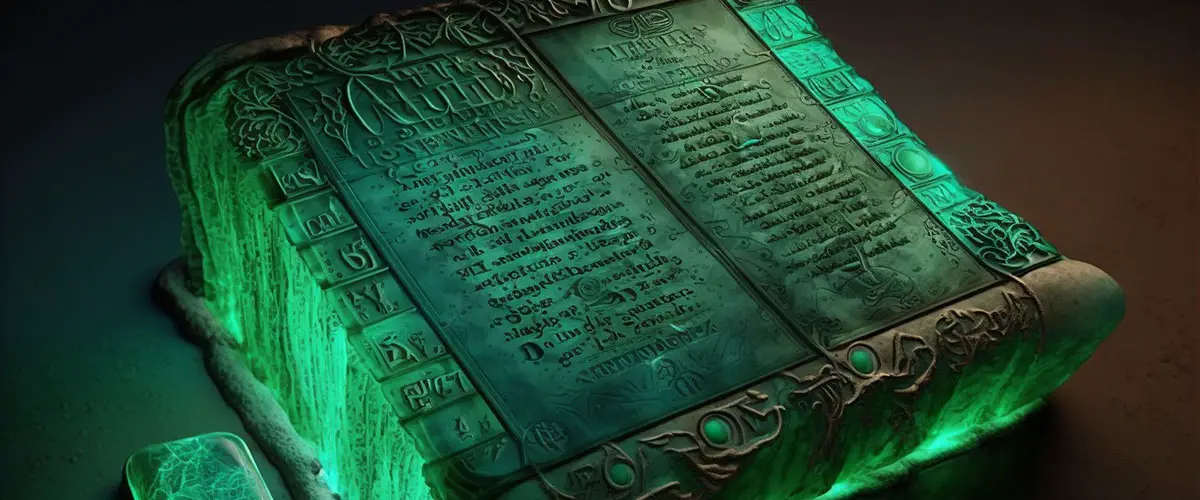The slab of stone known as the Emerald Tablet is enshrined in mystery. Engraved with ancient writing, its exact origins are unclear. In this article we are going to look at the question: how old is the Emerald Tablet?
The Emerald Tablets state that they were written in 36 000 BC, by Hermes Trismegistus. He wrote it during his time as king and high priest of the ancient civilization of Atlantis. However, the earliest known historical record of the Emerald Tablet appeared in a collection of Arabic texts during the 8th century.

The Mystery School Perspective on Dating the Emerald Tablet
According the tablets themselves, they were written some 38 000 years ago. This was before ancient Egypt, during the time of Atlantis, the mythical prehistoric civilization. Hermes had achieved immortality and dedicated his existence to teaching and guiding humanity to a higher level of consciousness.
When it came time for Hermes to depart from this part of the universe, he wrote his wisdom on the tablets, and put his students in charge of guarding and protecting them. These students became the priests of temple, passing the knowledge down from generation to generation. They became the high priests of ancient Egypt, and their knowledge was then passed to the ancient Greek philosophers. These traditions continue to exist in the form of secret societies such as the Freemasons, and the Golden Dawn, to name a couple well known examples.
In these traditions of esoteric study, the Emerald Tablets are recognized as being from the time of Atlantis, as that is what the texts themselves say, and also that is the knowledge that has been passed down from previous generations.
The Scientific Approach to Dating the Emerald Tablet
To take a more skeptical approach to dating the emerald tablet, one that follows the scientific method, a researcher may come to a different conclusion. Certainly, the profound nature of the writings of the Emerald Tablet are themselves evidence that the writings come from an unusual source, however there is no physical evidence to support the prehistorical origin date.
Dating the tablets themselves is not possible, as they have been lost, if they did in fact ever exist. They were supposedly made from a type of emerald-colored stone that only exists as a result of alchemical transmutation.
A popular theory is that they were lost during the burning of the Library of Alexandria. Located in Egypt, it was a large and significant place of research. Estimated to have contained the equivalent of 100 000 books in the form of scrolls, the library was attacked on multiple occasions, suffering its greatest loss of books in 48 BC, when it was accidentally set on fire by Julius Caesar during a civil war. If the legends of the tablets being made out of special alchemical stone are true, then they are indestructible, and therefore still buried under the ancient rubble of the burned library.

The oldest known reference to the Emerald Tablet is the Kitab- sir al-haliqi, which translates to Book of the Secret of Creation. This Arabic book is a composited collection of earlier works, and was written in the 8th century AD, by a writer name Balinas. This book was probably based on earlier Greek sources.
Part of this book is the author’s recount of discovering the Emerald Tablet himself, in a cave, under the statue of Hermes in Tyana (in modern Turkey). He claims that within the cave he discovered the corpse of Hermes Trismegistus himself, holding the Emerald Tablet in his hands. No archeological evidence has ever been found to support this claim.
Some scholars have interpreted Balinas’ book as proof that the Emerald Tablet was written in Arabic sometime between the 6th and 8th centuries, despite the fact that Balinas himself stated that the tablet was in Greek. A rich tradition of alchemy has existed in the Arabic world since Alexandrian times, and the Hermetic wisdom was almost forgotten in Europe for a period of time, being preserved in the Islamic world. Wither the Emerald Tablet emerged from this period of Arab philosophical development, or was inherited from the earlier Egyptians and Greeks, is a topic of much debate.
The Emerald Tablets in Modern Times
Interest in the Emerald Tablets has held strong right up until present time. There have been many translations made, into Greek and Latin and eventually English and probably most other modern languages.
In the 12th century AD the Emerald Tablet was translated into Latin by Hugo von Santalla, who used the Arabic Kitab- sir al-haliqi as his original source. In the thirteenth century another translation to Greek was published as part of the compilation known as Liber Hermetis de alchimia. This version became the basis for all later versions.
Isaac Newton wrote a translation, which was later discovered in his private alchemical studies. Known as one of the greatest and most influential scientists to ever live, he was also a member of secret societies, and a dedicated student of mysticism.

The full extent of his involvement in these societies is difficult to know, but he was a Rosicrucian, and also the president of the Royal Society. He dedicated his life to finding the Philosopher’s Stone, the magical substance used in alchemy to transmute base metals into gold. He also studied and wrote about ancient Greece, and even mentioned Atlantis on numerous occasions in his writings. His translation of the Emerald Tablets is now stored in King’s College Library, at Cambridge University.
The Emerald Tablet was also a point of focus amongst the occult magicians such as John Dee and Aleister Crowley during the 15th to 20th centuries. As they developed their magical systems, such as the Enochian language, or the book of Thelema, they turned to ancient Egypt and Hermeticism as the source of the higher knowledge they were looking for.
In summary, there is much that remains about the Emerald Tablet that is mysterious. We can choose to accept the 36 000 BC dating, that is contained within the writings themselves, and accepted by the mystery schools. Or we can take the academic route, tracing them back to the 8th century in Turkey, which ultimately is a dead end until new evidence emerges. In the meantime, we can continue to marvel at the profound nature of the writings themselves, and wonder about the fact that if they are in fact made of a special indestructible material, it is only a matter of time before they get discovered and dug up.
Recommended Reading
If you’d like to continue researching the Emerald Tablet, or any of the other topics discussed on this website, you can see which books I recommend by clicking here.

